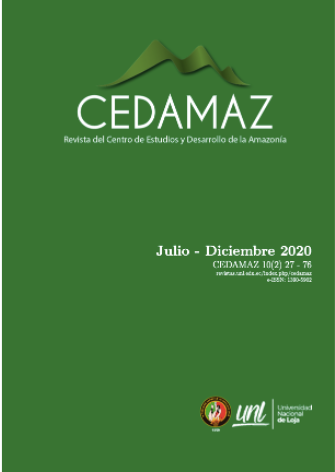Morphological response in different citrus species used as rootstocks, subjected to saline and water stress under greenhouse conditions
Abstract
Due to the current climate change conditions and the high susceptibility to abiotic stress, citrus fruits require the correct use of rootstocks that allows optimal production with tolerances to changing environmental conditions. For this reason, the behavior of three citrus rootstocks, undergone to saline and water stress due to deficit and excess, under greenhouse conditions was studied. Twelve treatments were established, resulting from three types of stress (salinity, water deficit and water excess) plus a control (optimal conditions) and three rootstocks (cleopatra mandarin, mandarin lemon and sour orange tree). For salinity, the substrate was maintained at 6 dS/m (electrical conductivity) and field capacity, in water deficit 40 % of the field capacity was applied, in excess 150 % of the field capacity was used, and under optimal conditions work was done at <1dS / m and field capacity. Vegetative and growth variables were measured (height, stem diameter, number of leaves, stomatal density, among others). Mandarin lemon obtained a significantly higher value in most variables (height, number of leaves, stem diameter, among others), whilst cleopatra mandarin was the one that exhibited the least development.Published
2021-07-02
How to Cite
Landín García, W. X. (2021). Morphological response in different citrus species used as rootstocks, subjected to saline and water stress under greenhouse conditions. CEDAMAZ, 10(2), 39–46. Retrieved from https://revistas.unl.edu.ec/index.php/cedamaz/article/view/894
Issue
Section
Research Articles
License

This work is licensed under a Creative Commons Attribution-NonCommercial-NoDerivatives 4.0 International License.
Those authors who have publications with this journal, accept the following terms:
- After the scientific article is accepted for publication, the author agrees to transfer the rights of the first publication to the CEDAMAZ Journal, but the authors retain the copyright. The total or partial reproduction of the published texts is allowed as long as it is not for profit. When the total or partial reproduction of scientific articles accepted and published in the CEDAMAZ Journal is carried out, the complete source and the electronic address of the publication must be cited.
- Scientific articles accepted and published in the CEDAMAZ journal may be deposited by the authors in their entirety in any repository without commercial purposes.
- Authors should not distribute accepted scientific articles that have not yet been officially published by CEDAMAZ. Failure to comply with this rule will result in the rejection of the scientific article.
- The publication of your work will be simultaneously subject to the Attribution-NonCommercial-NoDerivatives 4.0 International (CC BY-NC-ND 4.0)









